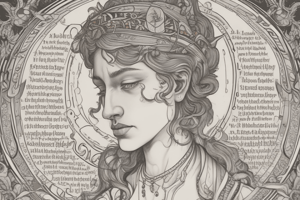Podcast
Questions and Answers
What distinguishes a lyric poem from other types of poetry?
What distinguishes a lyric poem from other types of poetry?
- It presents an emotional state from a single speaker. (correct)
- It is exclusively written for performance.
- It always follows a specific rhyme scheme.
- It tells a story with multiple characters.
Which of the following is NOT a subcategory of lyric poetry?
Which of the following is NOT a subcategory of lyric poetry?
- Ballad (correct)
- Sonnet
- Elegy
- Ode
How was the term 'elegy' used until the 17th century?
How was the term 'elegy' used until the 17th century?
- To describe any poem with a solemn theme. (correct)
- To indicate lighthearted poetry.
- To refer to love poems.
- To denote songs of joy.
What is the primary theme of Walt Whitman's elegy 'O Captain! My Captain!'?
What is the primary theme of Walt Whitman's elegy 'O Captain! My Captain!'?
What is a key characteristic of an ode?
What is a key characteristic of an ode?
What emotional state does a typical elegy convey?
What emotional state does a typical elegy convey?
Which element is retained in lyric poetry from its song origins?
Which element is retained in lyric poetry from its song origins?
What does the ship symbolize in Whitman's elegy?
What does the ship symbolize in Whitman's elegy?
What style are odes typically written in?
What style are odes typically written in?
Which of the following best describes the focus of an elegy?
Which of the following best describes the focus of an elegy?
Who is credited with writing the first odes?
Who is credited with writing the first odes?
What is a significant change in modern odes compared to earlier forms?
What is a significant change in modern odes compared to earlier forms?
What is the rhyme scheme of a Petrarchan sonnet?
What is the rhyme scheme of a Petrarchan sonnet?
Which type of sonnet consists of three quatrains followed by a couplet?
Which type of sonnet consists of three quatrains followed by a couplet?
What typically occurs at the turn or 'volta' in a Petrarchan sonnet?
What typically occurs at the turn or 'volta' in a Petrarchan sonnet?
What distinguishes a Shakespearean sonnet from a Petrarchan sonnet?
What distinguishes a Shakespearean sonnet from a Petrarchan sonnet?
What was the original focus of sonnets when they first emerged?
What was the original focus of sonnets when they first emerged?
Which poet wrote 'Ode to the West Wind'?
Which poet wrote 'Ode to the West Wind'?
What is one of the common topics sonnets addressed from the seventeenth century onward?
What is one of the common topics sonnets addressed from the seventeenth century onward?
In what meter are sonnets typically written?
In what meter are sonnets typically written?
What is the primary function of a narrative poem?
What is the primary function of a narrative poem?
Which of the following is a characteristic feature of an epic poem?
Which of the following is a characteristic feature of an epic poem?
What narrative structure do epics typically employ?
What narrative structure do epics typically employ?
What aspect does a mock-epic most commonly satirize?
What aspect does a mock-epic most commonly satirize?
Which famous work is an example of an epic poem?
Which famous work is an example of an epic poem?
What is a defining feature of epic poetry as mentioned in the content?
What is a defining feature of epic poetry as mentioned in the content?
Which element typically enhances the narrative of an epic?
Which element typically enhances the narrative of an epic?
What is the significance of invoking a muse in an epic poem?
What is the significance of invoking a muse in an epic poem?
How does a mock-epic differ from a traditional epic?
How does a mock-epic differ from a traditional epic?
In what manner do narrative poems typically convey their plots?
In what manner do narrative poems typically convey their plots?
What is a key feature of a dramatic monologue?
What is a key feature of a dramatic monologue?
In 'My Last Duchess', what aspect of the Duke's character is revealed?
In 'My Last Duchess', what aspect of the Duke's character is revealed?
What is occasional poetry specifically written for?
What is occasional poetry specifically written for?
What does the term 'epithalamion' refer to?
What does the term 'epithalamion' refer to?
What is the main subject of Edmund Spenser's 'Epithalamion'?
What is the main subject of Edmund Spenser's 'Epithalamion'?
In 'My Last Duchess', how does the Duke describe the portrait of his wife?
In 'My Last Duchess', how does the Duke describe the portrait of his wife?
What primary emotion does the speaker of a dramatic monologue often convey?
What primary emotion does the speaker of a dramatic monologue often convey?
What does the presence of a silent auditor imply in a dramatic monologue?
What does the presence of a silent auditor imply in a dramatic monologue?
What atmosphere is typically created in Browning's 'My Last Duchess'?
What atmosphere is typically created in Browning's 'My Last Duchess'?
What does the Duke imply about his late wife in his speech?
What does the Duke imply about his late wife in his speech?
Flashcards are hidden until you start studying
Study Notes
Lyric Poetry
- Defined as a short, non-narrative poem expressing a single speaker's emotional state.
- Originated from songs accompanied by the lyre in ancient Greece.
- Subcategories include elegy, ode, sonnet, dramatic monologue, and occasional poetry.
Elegy
- Traditionally denoted any solemn poem until the 17th century; now refers to poems lamenting death or loss.
- E.g., Tennyson's "In Memoriam A.H.H." reflects on personal loss.
- Broader elegies focus on themes of death, such as Gray's "Elegy Written in a Country Churchyard."
Example of an Elegy
- Walt Whitman's "O Captain! My Captain!" mourns President Abraham Lincoln's assassination.
- The poem conveys themes of grief and homage through its address and imagery.
Ode
- A long lyric poem addressing a particular subject in an elevated style.
- Originated with Greek poetry, notably from Pindar in the 5th century BC.
- Modern odes vary in structure and often lack a formal rhyme scheme.
- E.g., Wordsworth’s "Hymn to Duty" and Keats’ "Ode to a Grecian Urn" exemplify this form.
Example of an Ode
- Percy Bysshe Shelley's "Ode to the West Wind" invokes natural elements as a metaphor for transformation and renewal.
Sonnet
- Derived from the Italian 'sonetto,' meaning 'little song.'
- Initially a love poem, the sonnet evolved to encompass various themes, including religion, art, and war.
- Comprises a single stanza of typically 14 lines, following intricate rhyme patterns.
- Linked thematic series of sonnets, known as sonnet cycles, are prevalent among poets like Petrarch and Shakespeare.
Petrarchan Sonnet
- Characterized by two stanzas: an octave (first 8 lines) presenting a theme, followed by a sestet (last 6 lines) that addresses the theme.
- Includes a volta (turn) between the 8th and 9th lines.
- Rhyme scheme: ABBA, ABBA, CDE, CDE.
Shakespearean Sonnet
- Consists of three quatrains followed by a concluding couplet (two lines).
- Each quatrain develops a different aspect of the theme, with the couplet providing resolution or insight.
- Rhyme scheme: ABAB, CDCD, EFEF, GG.
Example of a Shakespearean Sonnet
- Shakespeare's sonnet 130 challenges idealized beauty conventions, using vivid comparisons to portray his mistress authentically.
Dramatic Monologue
- A poetic form where a single character speaks, revealing thoughts and feelings directed at an implied audience.
Dramatic Monologue
- A speaker delivers a speech to a silent listener, revealing their character and temperament unintentionally.
- Example: In Robert Browning's "My Last Duchess," the Duke reveals his pride and jealousy while showing a portrait of his deceased wife to a prospective new husband.
Occasional Poetry
- Written for specific occasions such as weddings, deaths, or historical events.
- Examples include:
- "Epithalamion" by Edmund Spenser for weddings (epithalamion is a wedding poem).
- "Annus Mirabilis" by John Dryden commemorating the return of a king.
- Milton's "Lycidas" as a elegy for a friend.
Narrative Poetry
- Tells a story through verse, featuring a sequence of connected events and a narrator.
- Sub-categories include epic, mock-epic, ballad, and romance.
- Themes include love stories (Tennyson's "Maud"), familial tales (Wordsworth's "Michael"), and heroic deeds (Walter Scott's "Lay of the Last Minstrel").
Epic Poetry
- A long narrative that deals with significant themes or subjects, often in an elevated style.
- Features:
- A heroic figure of great importance.
- A vast setting and superhuman deeds.
- Involvement of gods or supernatural aspects.
- Formal introductions of characters and in medias res beginnings (starting in the midst of action).
- Classic examples include Homer's works and Virgil’s "Aeneid," along with Beowulf and Milton's "Paradise Lost."
Example of an Epic
- Milton's "Paradise Lost" opens by addressing the themes of disobedience and redemption while invoking a muse for inspiration.
Mock-Epic
- Utilizes epic conventions to address trivial subjects, often satirizing societal issues like pretentiousness or superficiality.
- Notable example: Alexander Pope's "The Rape of the Lock," which humorously recounts the cutting of a woman's hair.
Studying That Suits You
Use AI to generate personalized quizzes and flashcards to suit your learning preferences.



